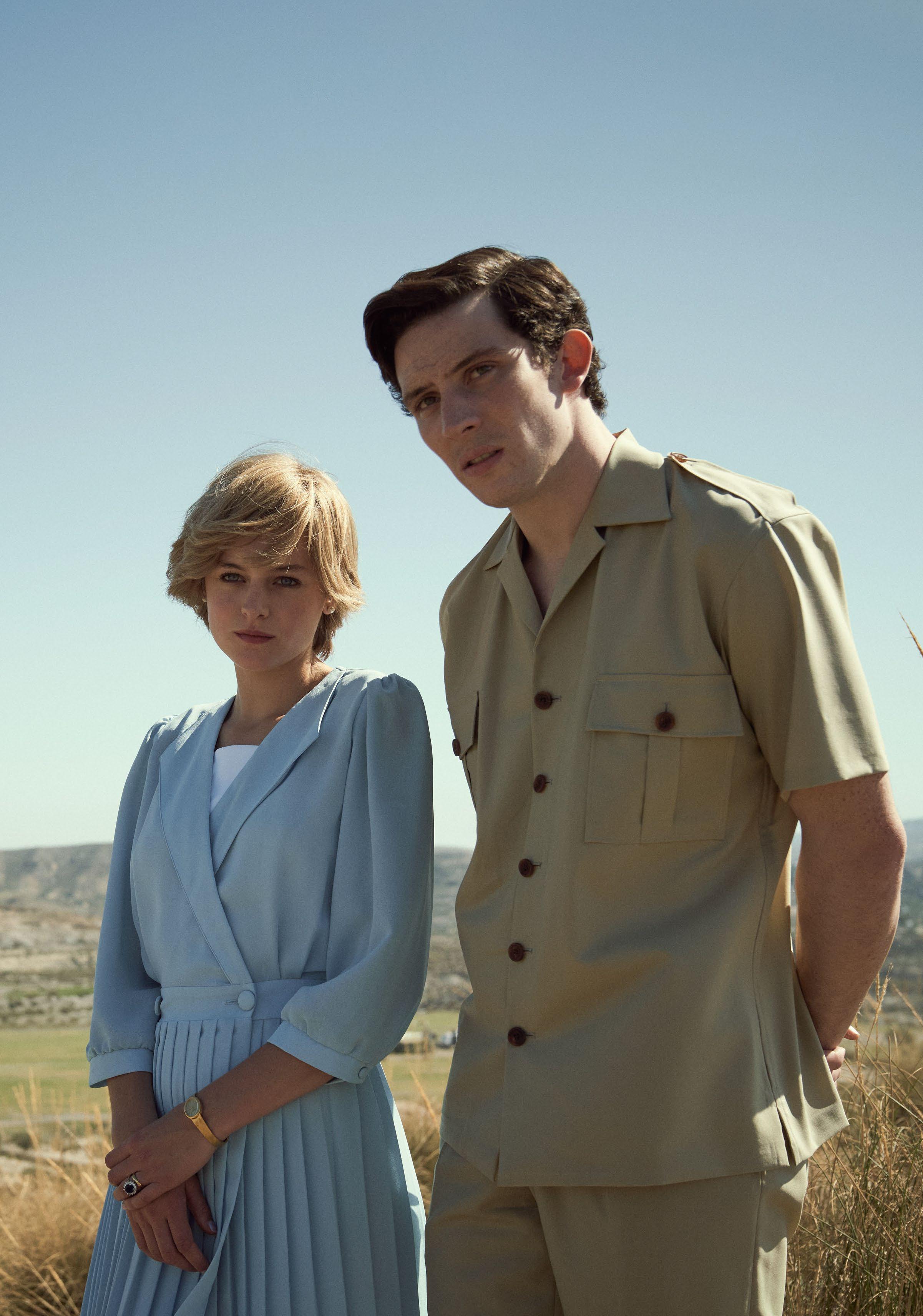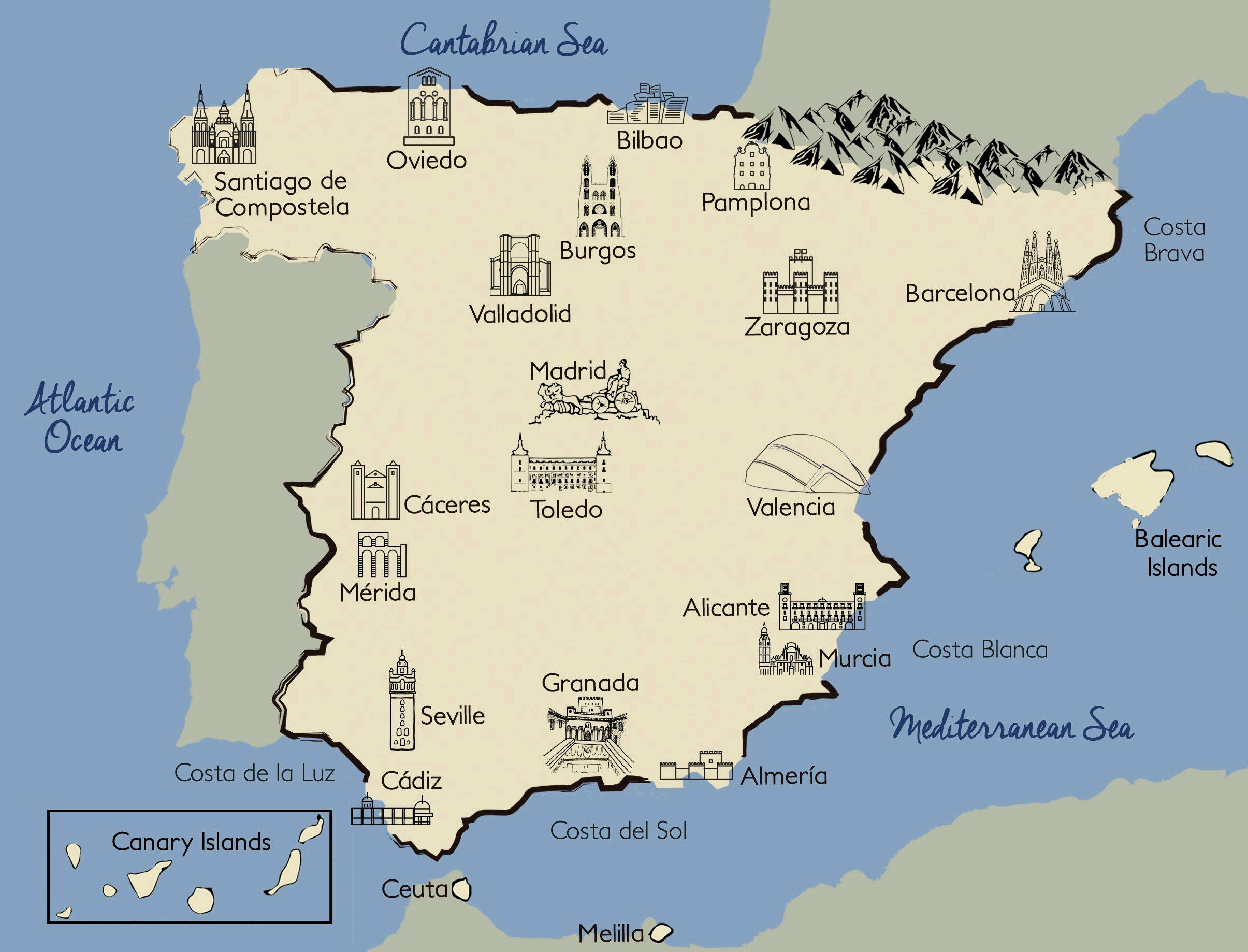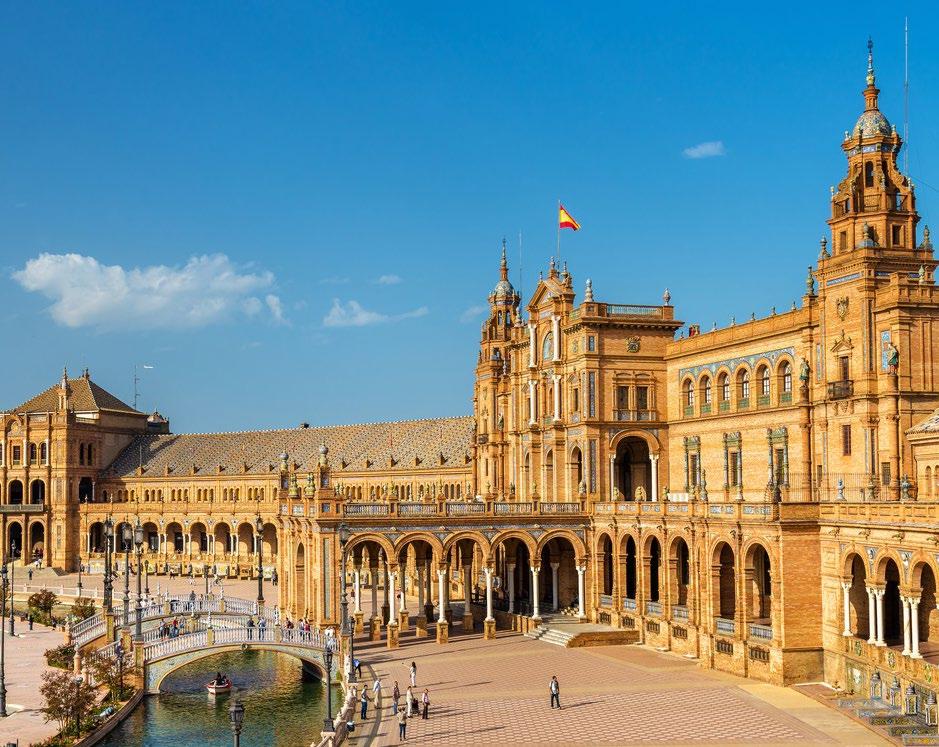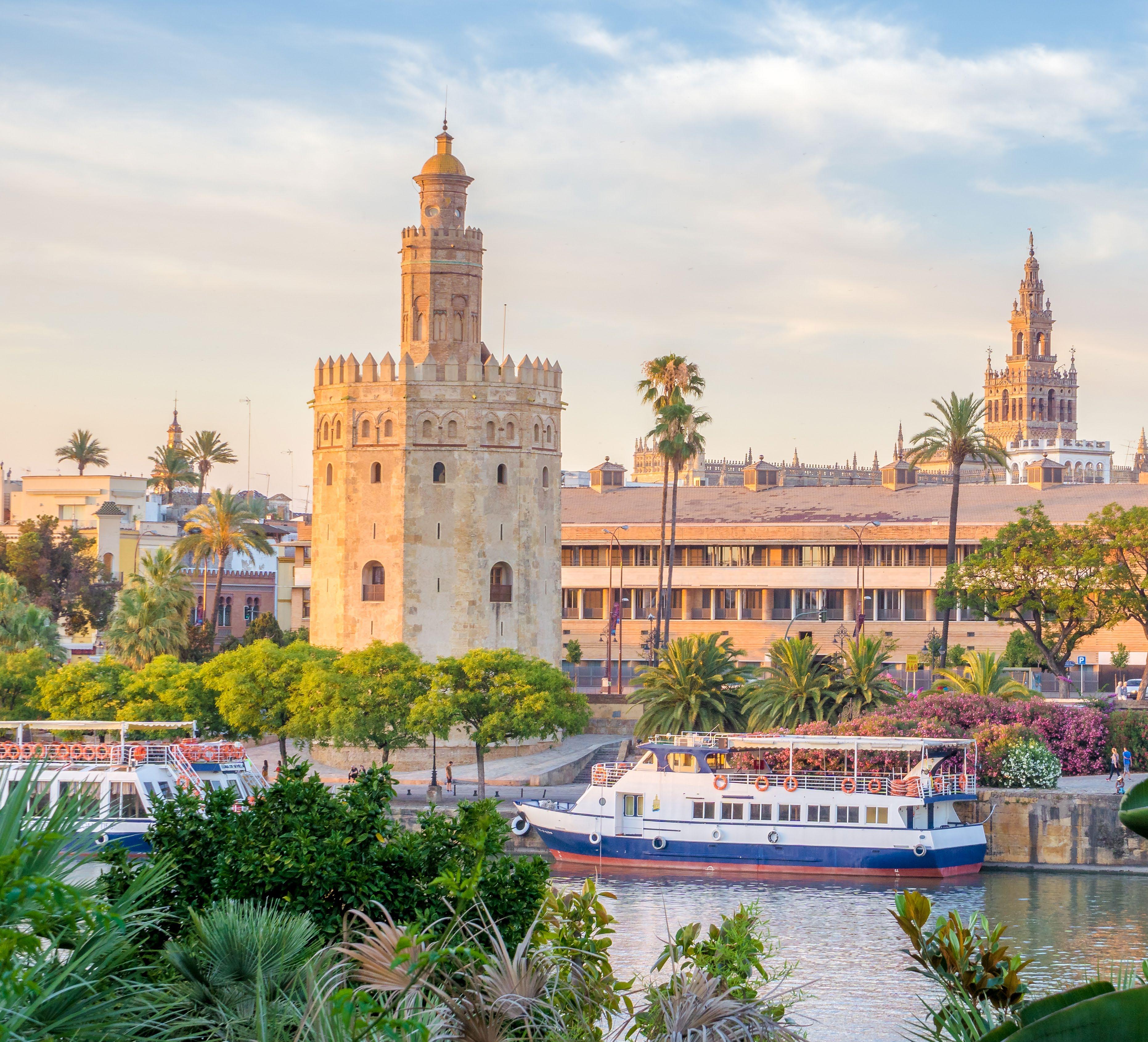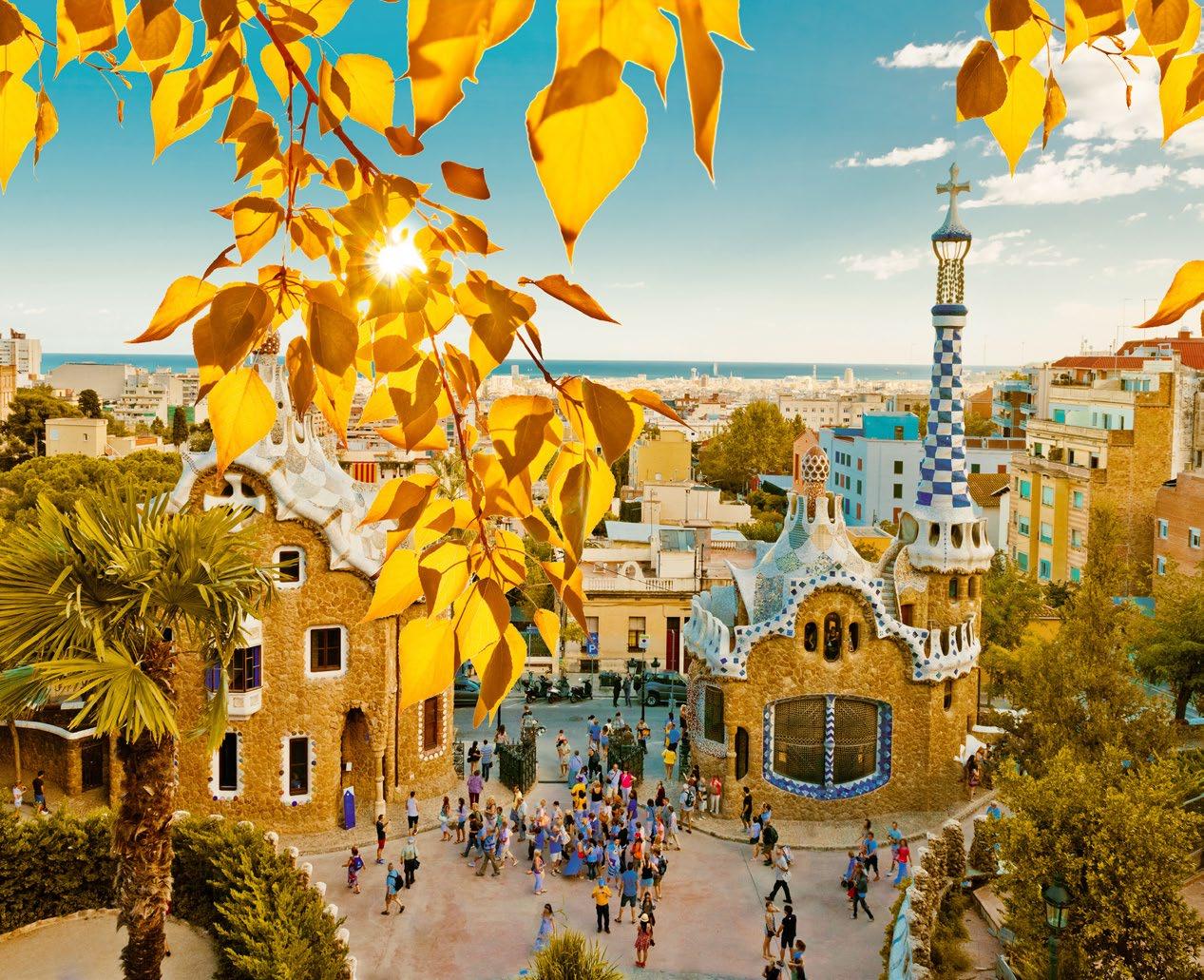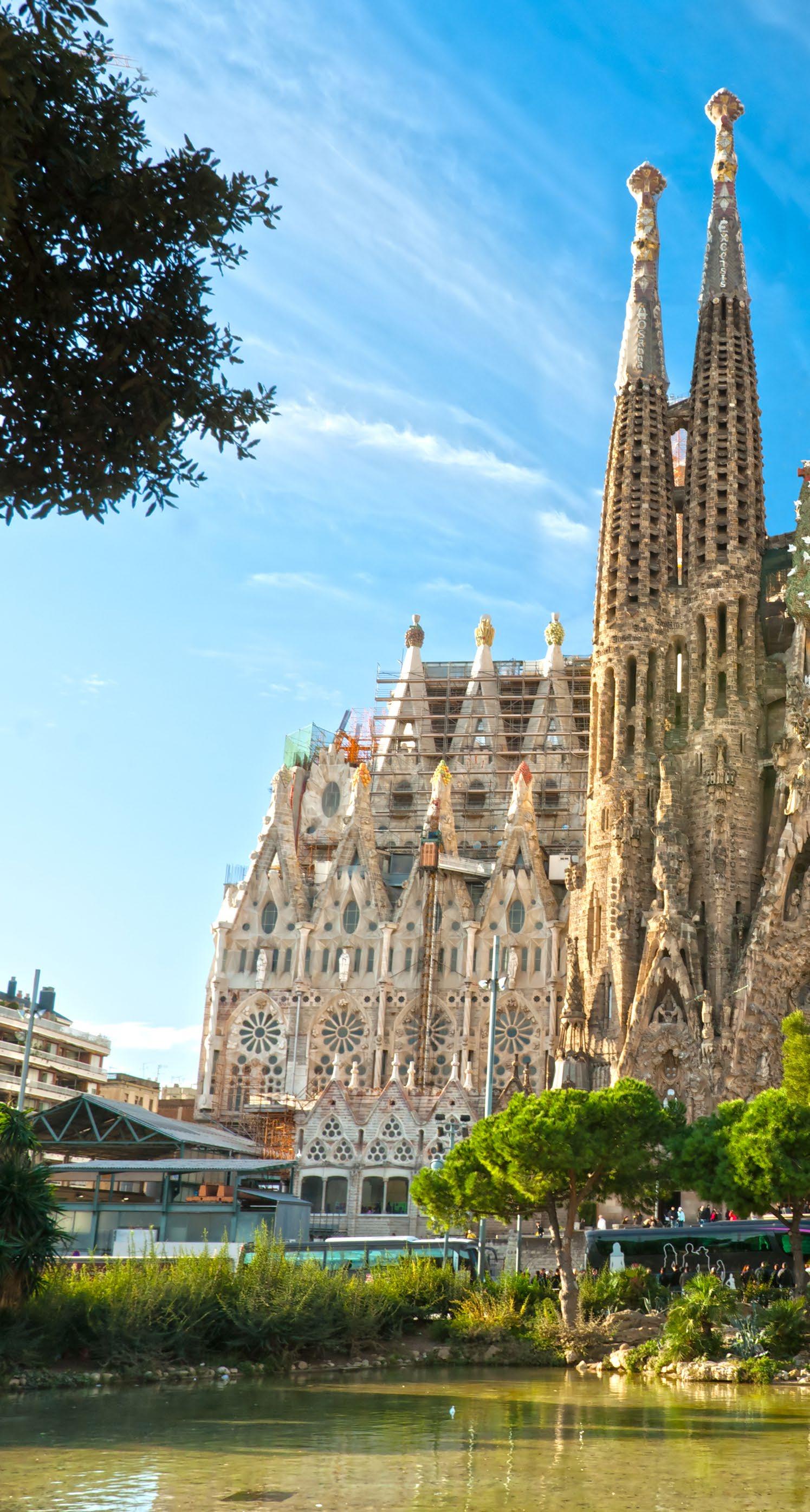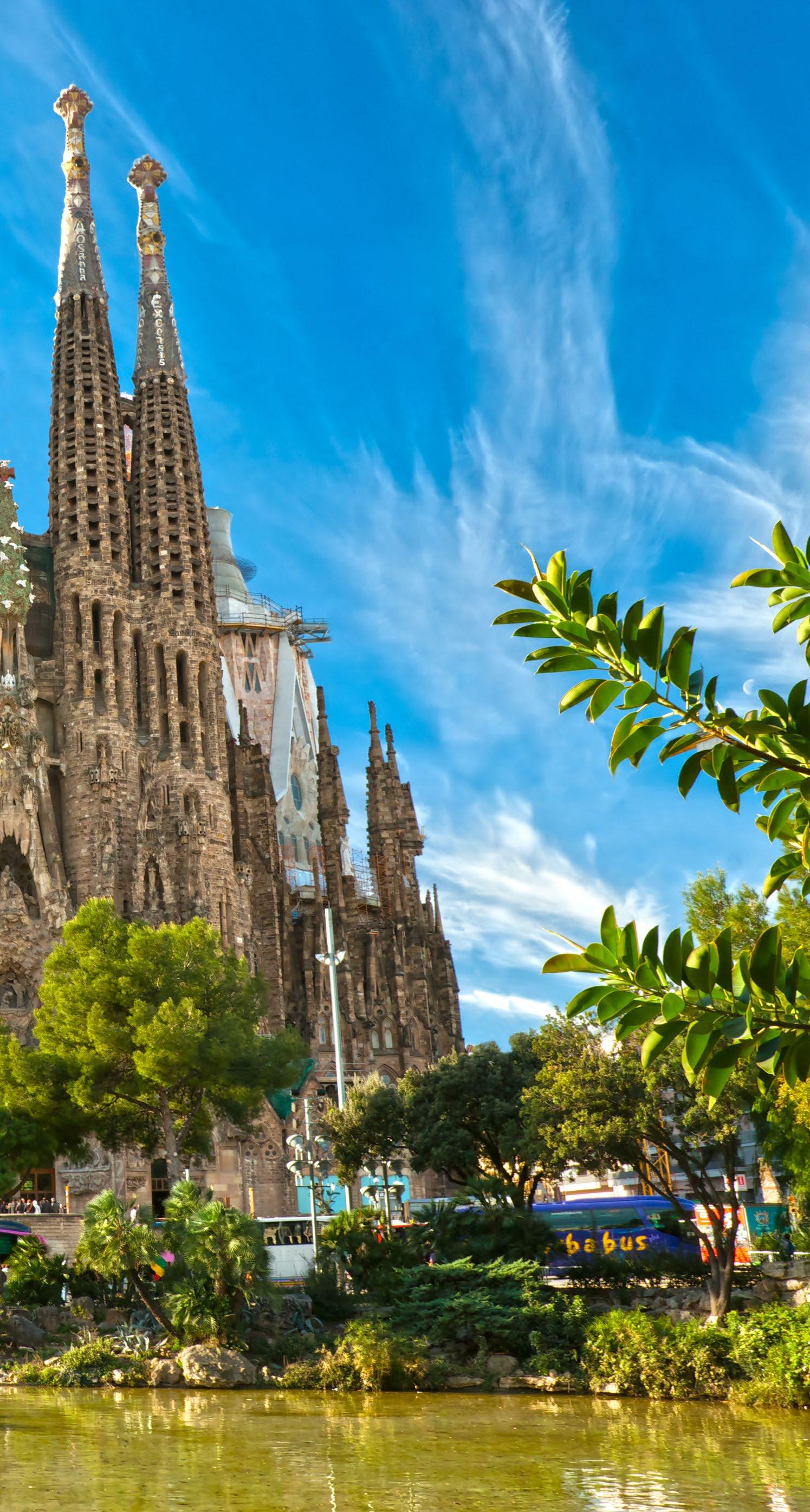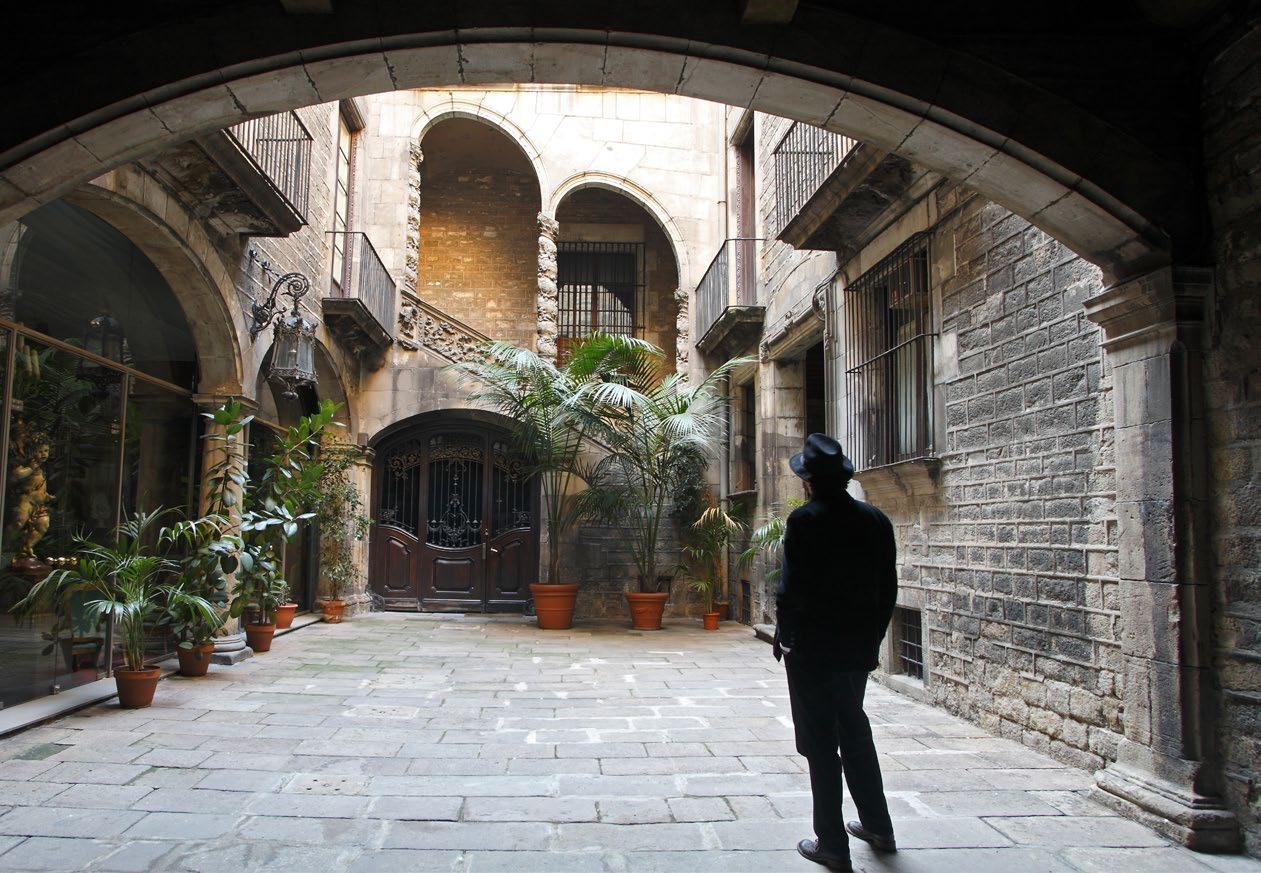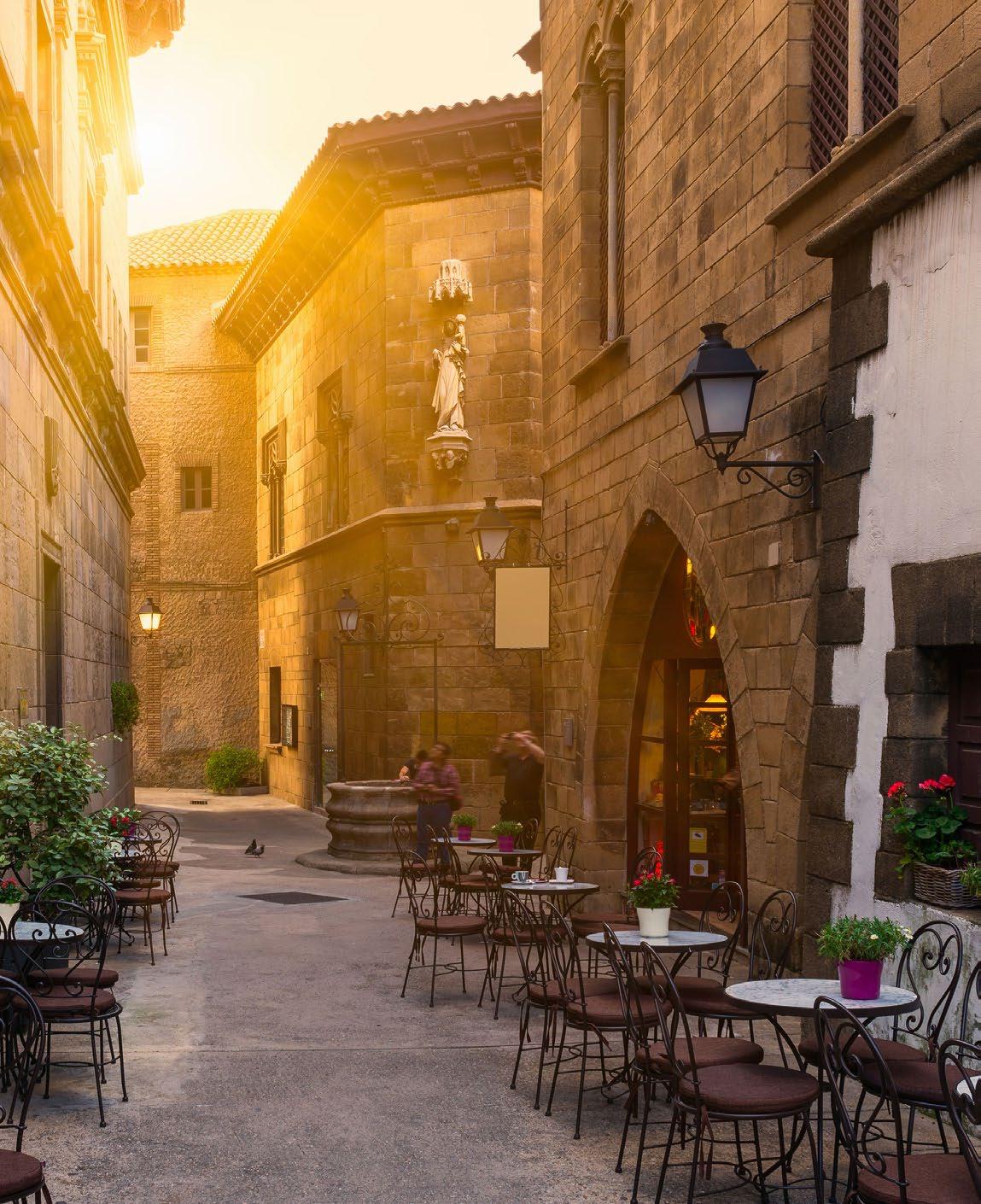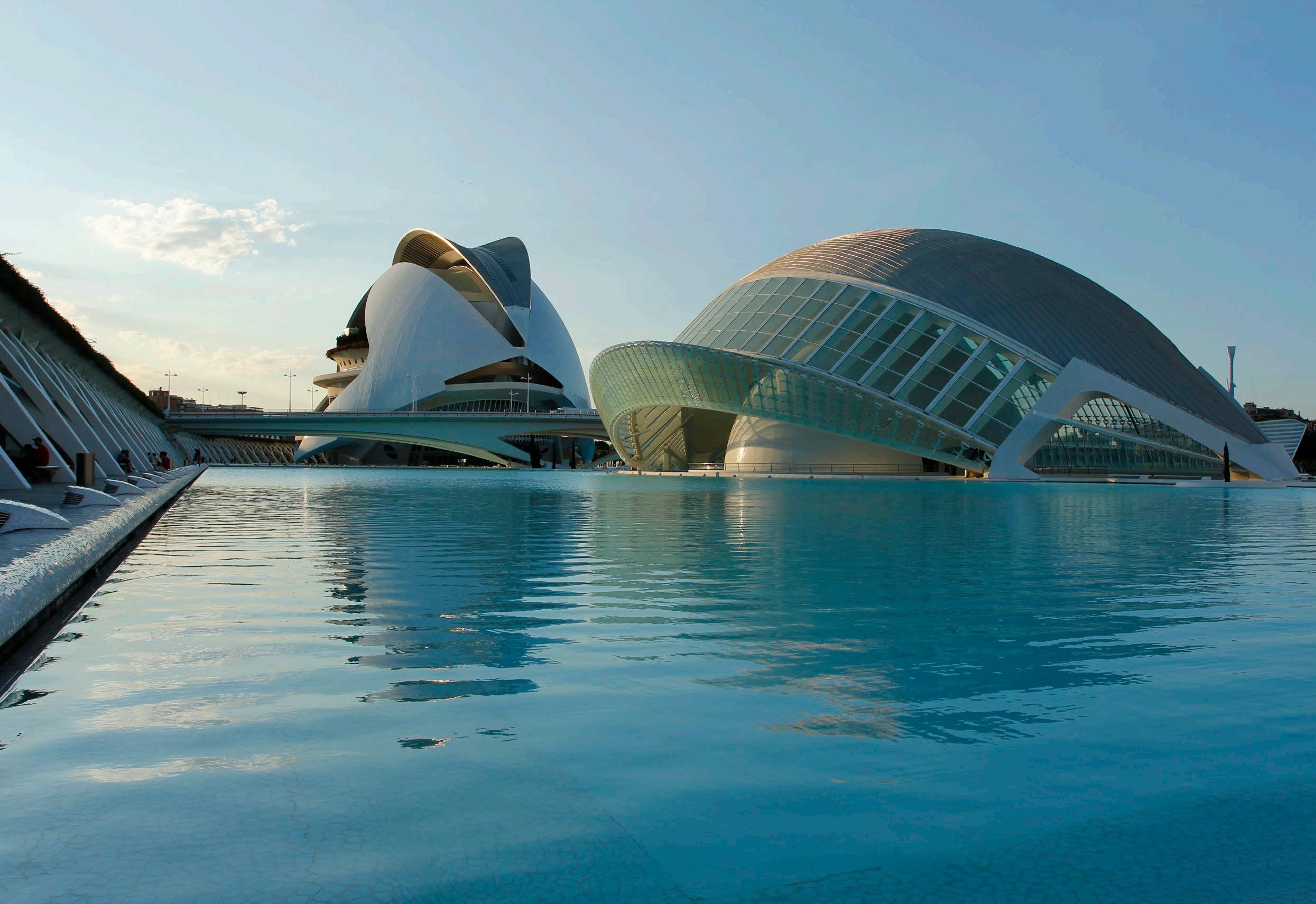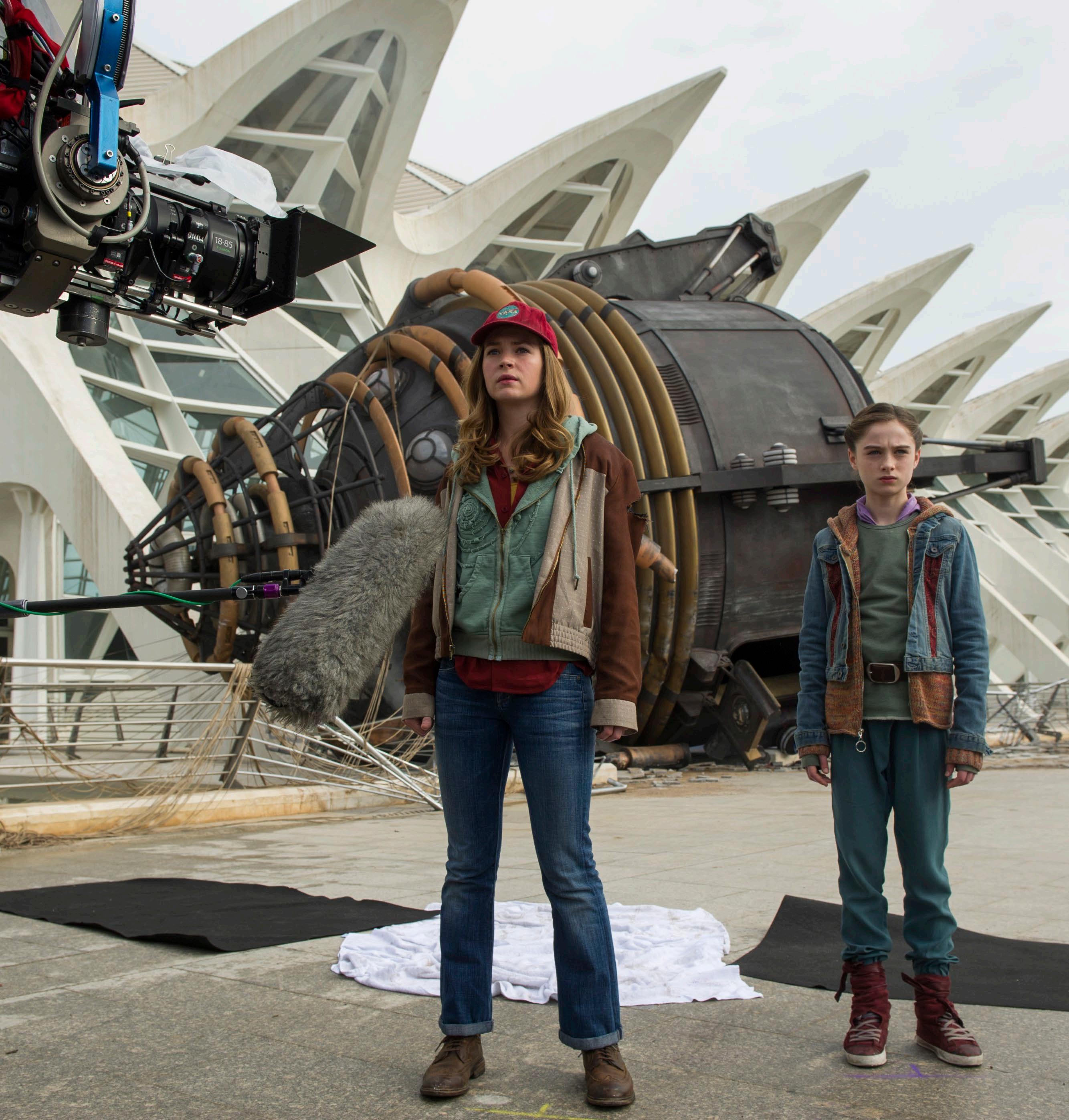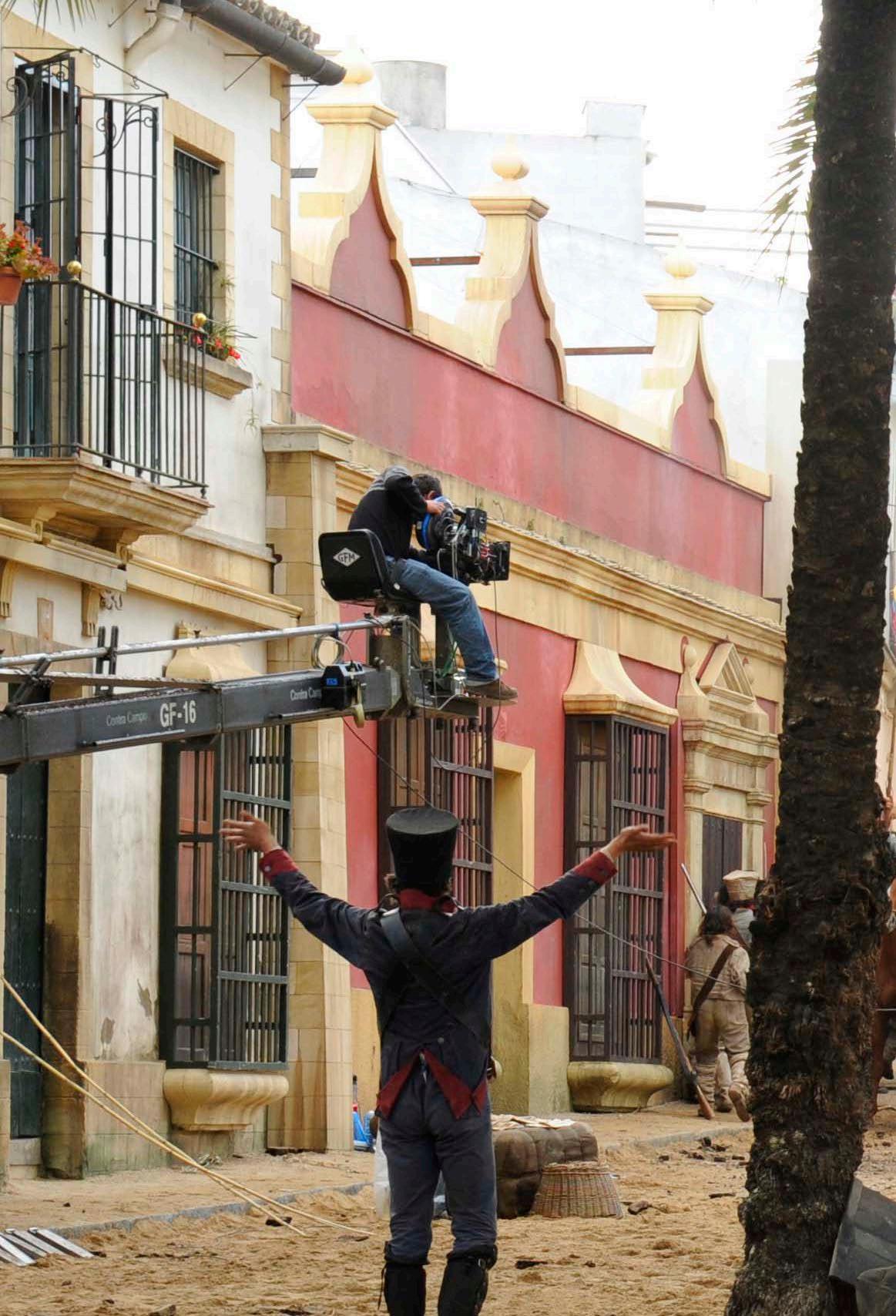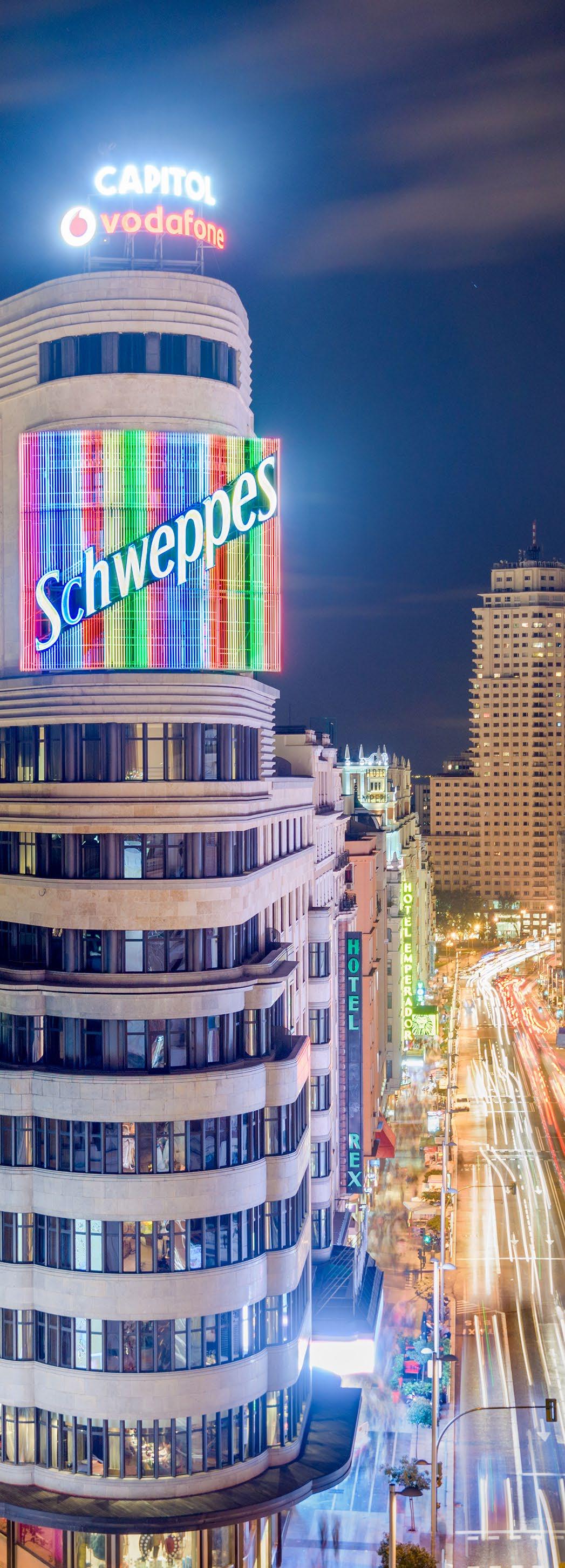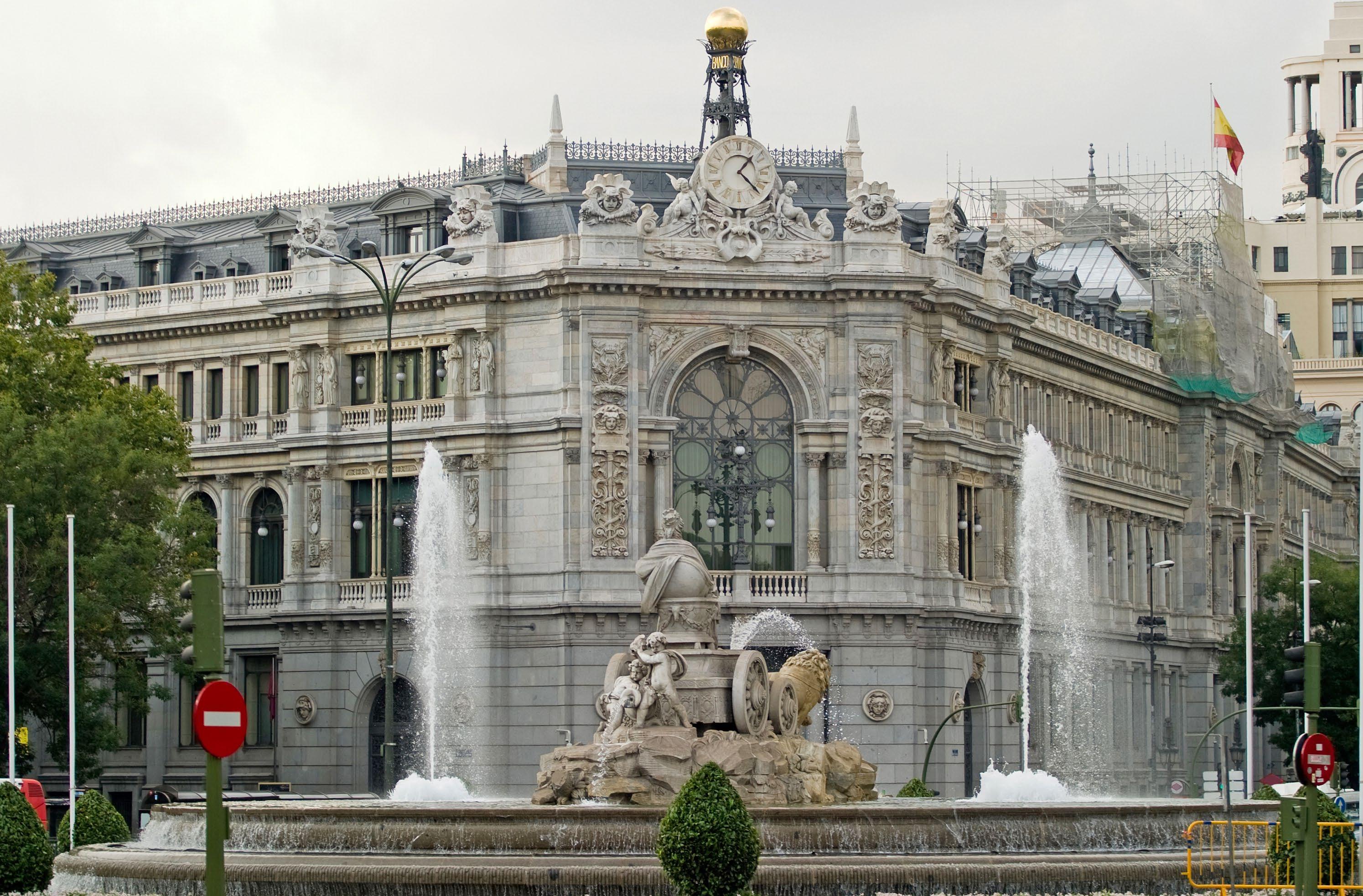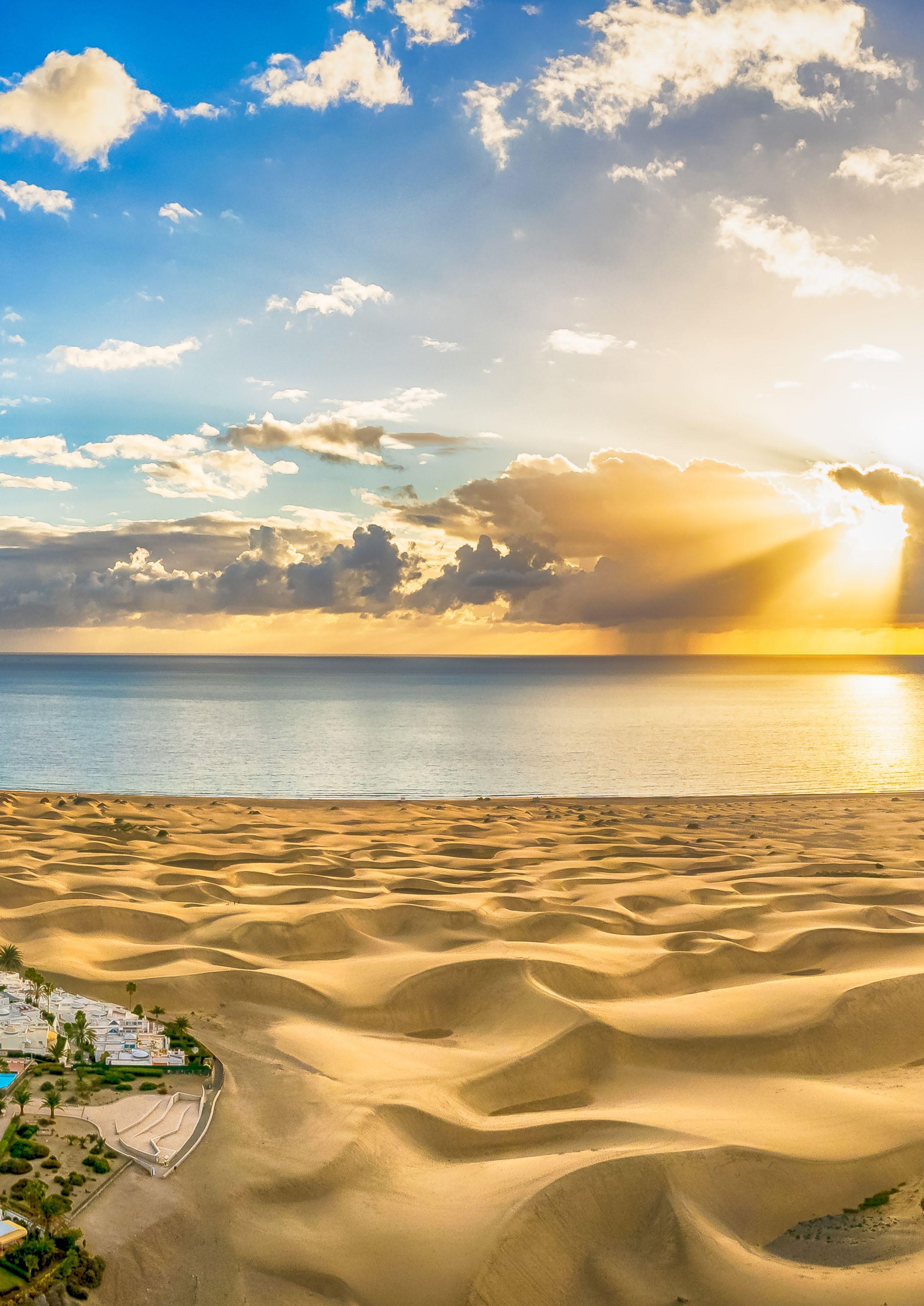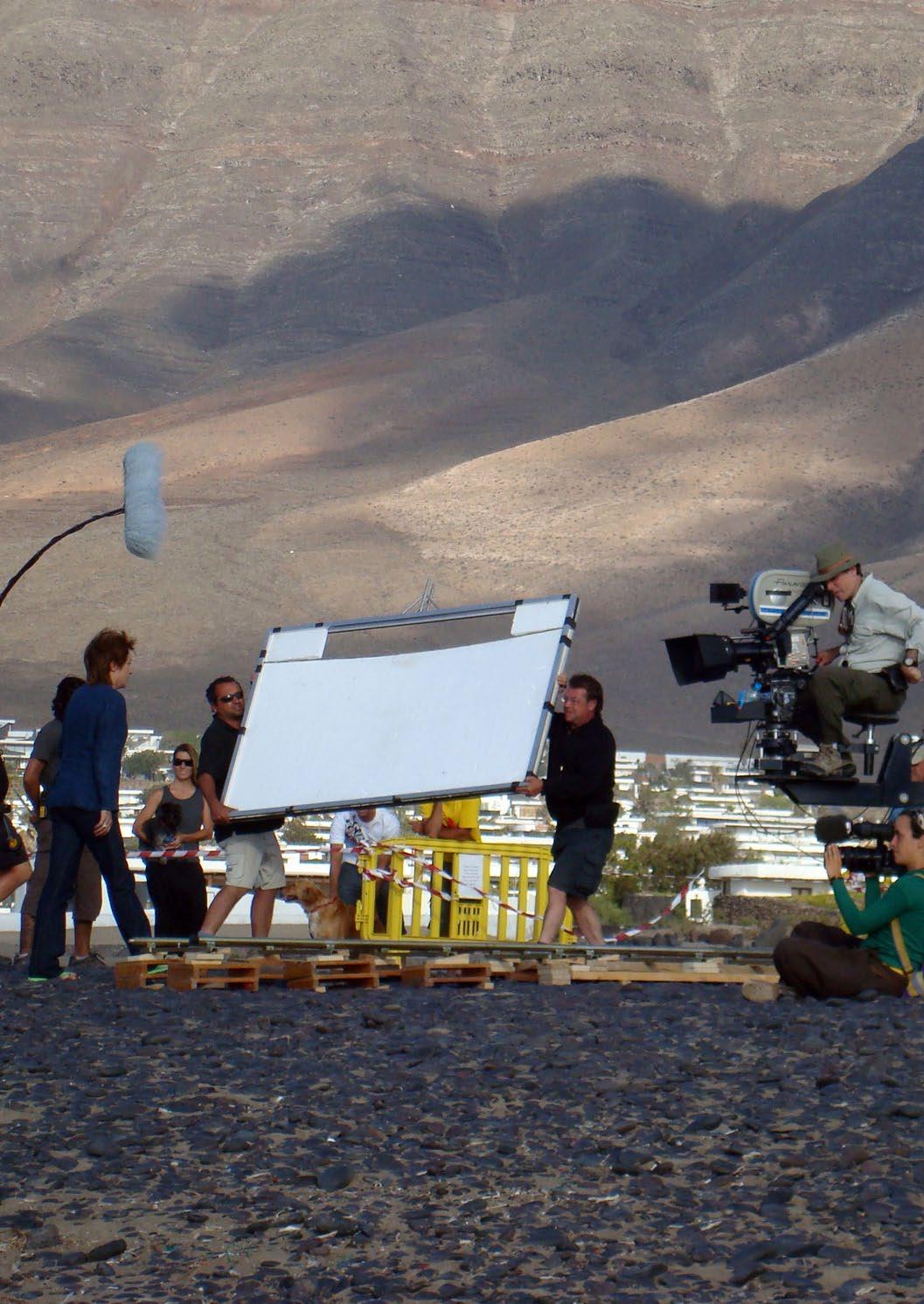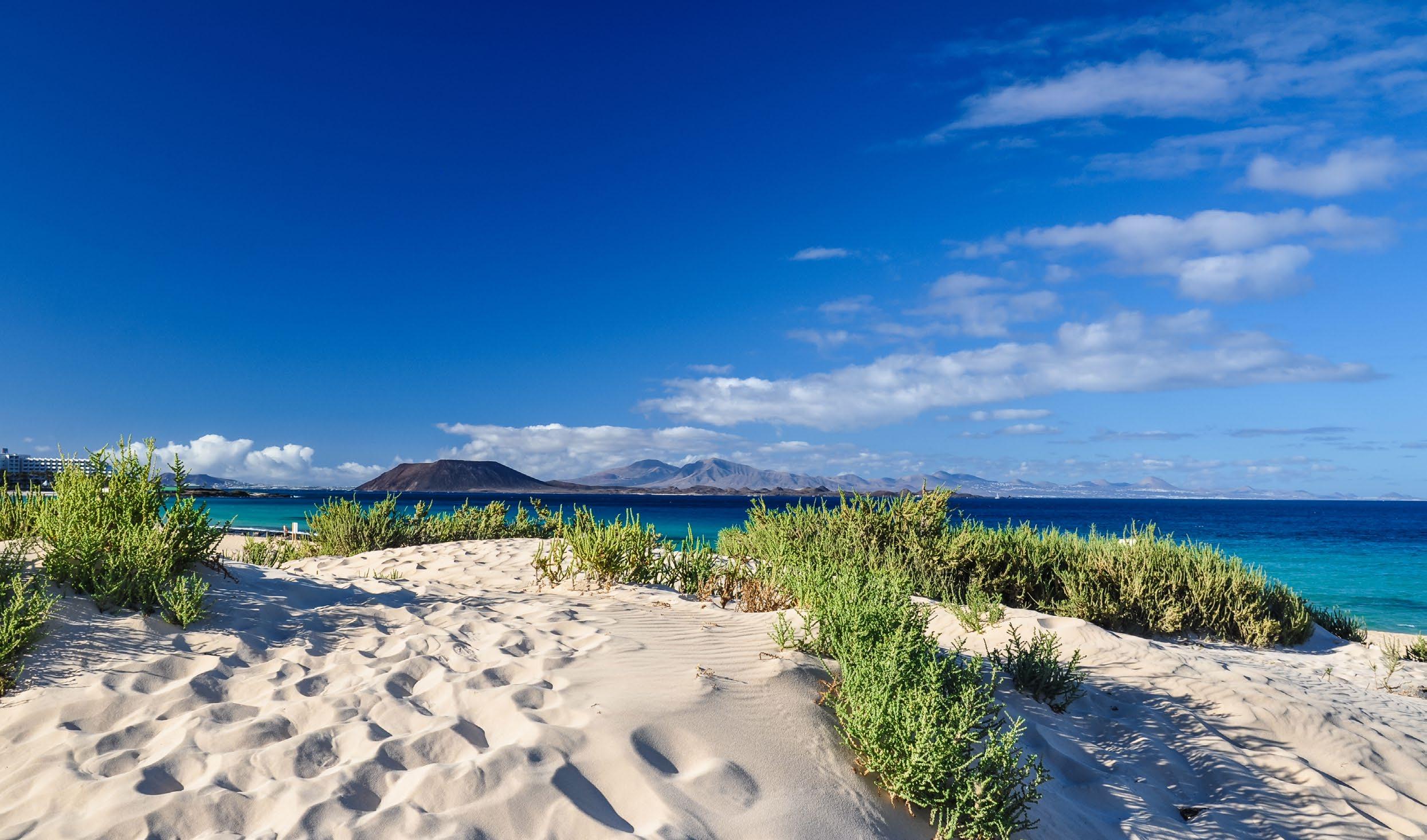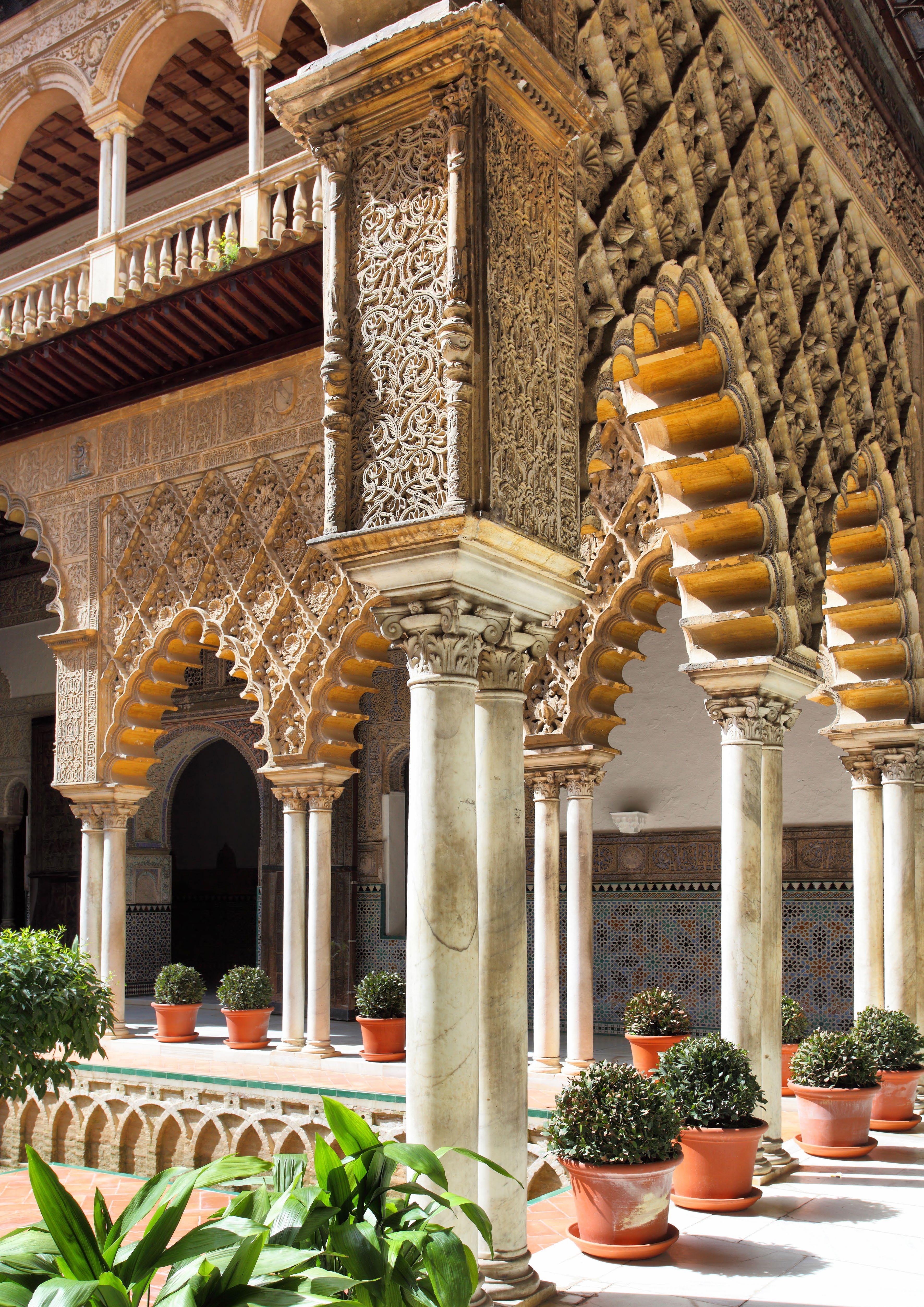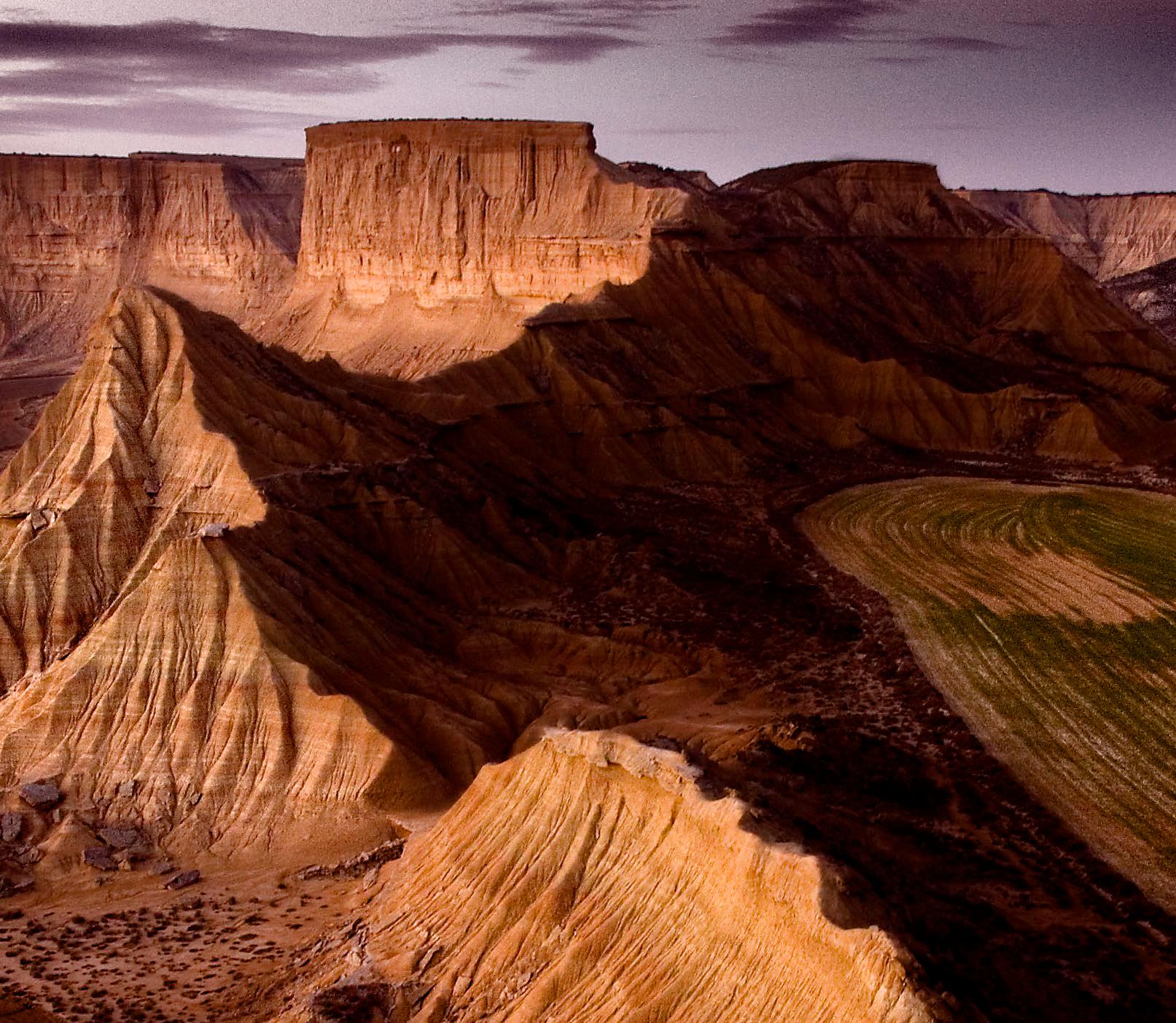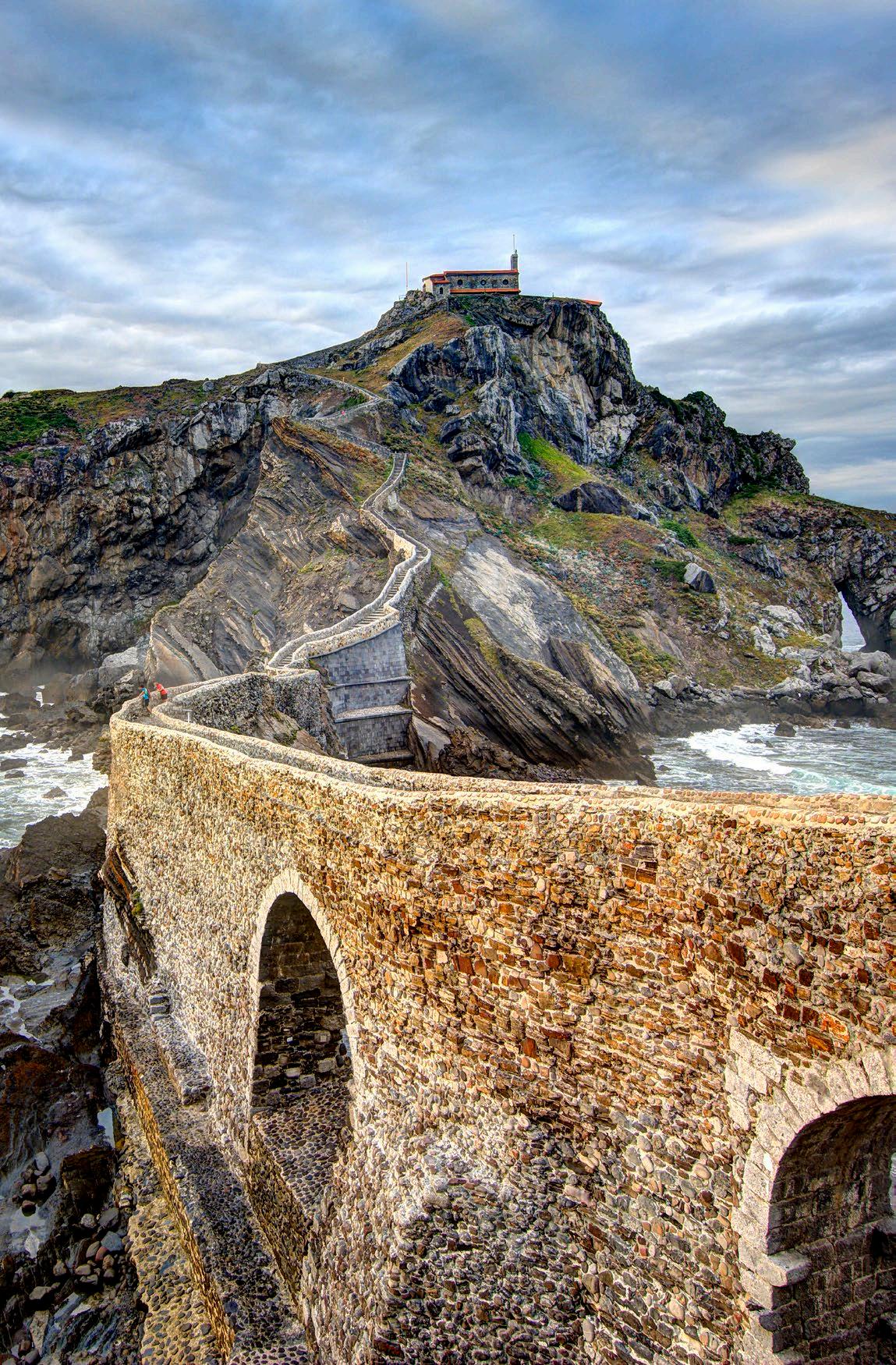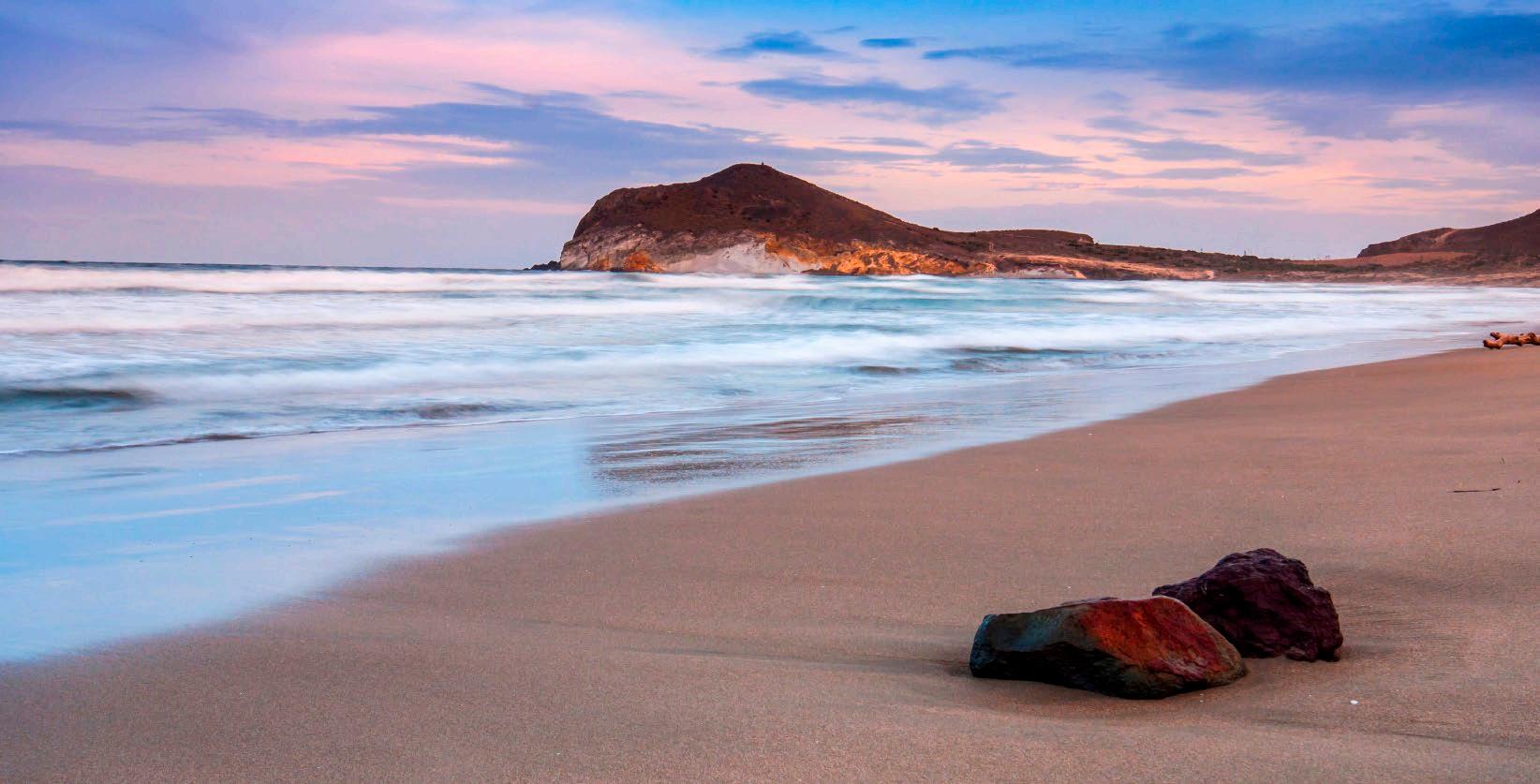ESSENTIAL LOCATIONS IN SPAIN
Spain's incredible wealth of monuments and nature makes it a real goldmine for filmmakers. Visit the places that appear in some of your favourite films and discover what our country has to offer.
CITIES THAT ARE TRANSFORMED
Emblematic streets, picture-postcard corners, monuments and historical buildings, nature parks, etc., are some of the favourite locations for renowned directors and the top level productions that have been shot in different Spanish cities.
SEVILLE
To create the images of the beautiful Theed Palace, in the capital city of planet Naboo, George Lucas used Plaza de España in Seville, which provided the perfect location for shooting a sequence of Star Wars: Episode II - Attack of
the Clones. This is one of the city's most spectacular spots: a semicircular plaza walked in by a young Anakin Skywalker, Princess Amidala and the ever faithful R2-D2.
a PLAZA DE ESPAÑA SEVILLE
Cádiz, also in Andalusia, has been the setting for famous films like James Bond’s Die Another Day.
In addition to the large central plaza, its fountain and some of its bridges, what is seen in the film with more detail and no special effects is the network of galleries under the buildings, comprising a porticoed walkway capable of transporting you to a very, very far off galaxy.
This same square was the setting for colonial-era Cairo in Lawrence of Arabia Its extravagant architecture was chosen by director David Lean to recreate the early 20th-century buildings needed for his film.
Seville’s rich heritage means the city is the ideal backdrop for any period production. It is no coincidence that Ridley Scott has chosen Seville to shoot sev-
eral of his films. For example, Kingdom of Heaven, in which this city on the Guadalquivir River is used to represent Jerusalem in the 12th century, thanks to buildings like the Real Alcázar Fortress, which was transformed into the Palace of King Baldwin during the time of the Crusades.
A stroll in the orange tree gardens, courtyards and fountains of this home to kings and high dignitaries of the Middle Ages will transport you to the Far East. The beautiful Monteria courtyard is where Balian (Orlando Bloom) and Princess Sibyl of Jerusalem (Eva Green) meet for the first time and seal their fate.
Casa de Pilatos is another of the places that captivated Scott, who chose this palace in Italian-Mudéjar Renaissance style as the location for the residence of the Roman praetor in Jerusalem. Take a look inside and go into the very beautiful gardens, typical of noble palaces in the city centre, with beautiful plaster skirting and Plateresque style grilles.
It was not the first time that Scott succumbed to Seville's charms. In 1492: Conquest of Paradise, a film about the discovery of America, he had already used both locations. Within the Alcázar Fortress, Rey Don Pedro Palace was the residence of Queen Isabella I (Sigourney Weaver), who received the visit of Christopher Columbus (Gérard Depardieu). It is a key moment in history, the start of negotiations in which Columbus asked the queen to support his quest to reach the Indies by a new maritime route.
Tom Cruise and Cameron Diaz shook up the city during the weeks in which they shot the action comedy Knight and Day, directed by James Mangold. Dizzying chase scenes take place in the beautiful streets next to the cathedral. Monumental buildings, like the previously mentioned Casa de Pilatos Palace, are converted into places such as the home of a rich arms dealer.
Game of Thrones has also left its mark in Seville, featuring its streets and buildings in several episodes across the seasons.
The city has hosted the characters of one of the most famous TV series, The Crown, which transformed the Alfonso XIII hotel into the Beverly Hills Hotel in Los Angeles, in the third season.
a THE MERCURY POOL GARDEN REAL ALCÁZAR PALACE, SEVILLE
BARCELONA
One of the most photogenic cities in Spain is Barcelona. And if there is one film that is a tribute to the main tourist attractions of the capital city of Catalonia, it is Vicky Cristina Barcelona, by Woody Allen.
The filmmaker from New York had it quite clear while writing the script: "it's a city full of visual beauty, with a very romantic feel." And so naturally the film, in which Scarlett Johansson and Rebecca Hall play two US tourists, offers a tour of Barcelona comparable to the best travel guide.
The magic of the buildings and spaces created by Antoni Gaudí are fundamental in the story that Woody Allen unfolds for us. Buildings such as the Basilica of La Sagrada Familia, in the heart of the city, the greatest example of modernism, in which the couple of
friends are seen taking photos. Climb up to its pointed towers to get a beautiful panoramic view of the city.
The characters also enjoy all the details of the rooftop terrace of La PedreraCasa Milà, one of the best examples of Gaudí's taste for sinuous forms. Trencadís (broken-tile mosaic), stone, marble and glass are fundamental elements of a building worthy of an Oscar.
Another scene, with Javier Bardem and Rebecca Hall, is shot in Güell Park by
a GÜELL PARK BARCELONA
the lizard-shaped fountain. The park's curious shapes and bold colour combinations, mixed with its vegetation, will transport you to a magical world.
Special mention should be made of some of Barcelona's most outstanding museums where the film's characters appear, such as the Fundació Joan Miró, the Museu Nacional d’Art de Catalunya and the exterior of MACBA, the city's main contemporary art museum.
Other sites that you can discover following the steps of the characters in this film are the Tibidabo amusement park, with unsurpassed views of the city, the setting for scenes from The Machinist starring Christian Bale; the hustle and bustle and traditional flower stalls of La Rambla thoroughfare or the charming Plaza de San Felipe Neri square. In addition to Barcelona, Woody Allen's film also has scenes in Oviedo and Avilés (Asturias), two cities of which the New York genius declares himself to be an admirer.
a THE BASILICA OF LA SAGRADA FAMILIA BARCELONA
b LA PEDRERA-CASA MILÀ BARCELONA
Perfume: The Story of a Murderer, based on the bestseller by Patrick Süskind and directed by Tom Tykwer, is another perfect feature film for discovering the charms of Barcelona, here converted into 18th century Paris. The narrow streets of the Gothic Quarter are the setting for the wanderings of Grenouille, the film's protagonist. There you can see the city's Roman past, ruins of ancient walls, the narrow streets of the Jewish quarter, the Gothic cathedral and the most important of its palaces.
Some of the corners of the city shown in Perfume: The Story of a Murderer are not so well known. We are talking about Laberint d'Horta Park, in the north of the city, with its intricate maze of cypresses, temples, fountains and mythological sculptures. And Poble Espanyol, an open-air architectural museum located at the foot of Montjuïc hill, with scaled reproductions of buildings, squares and streets representative of various Spanish cities. Its main square is the scene of the film's culminating moment.
Also filmed here in 2006, was the Italian comedy Manuale d'amore 2, directed by Giovanni Veronesi, in which the beauty of Monica Bellucci and Elsa Pataky shone brightly in the streets of the Gothic Quarter, the Olympic Port and on Barceloneta Beach.
Other great declarations of love for Barcelona are All About My Mother, the production with which Pedro Almodóvar won the Oscar in 1999, and Pot Luck (L'Auberge Espagnole), a French comedy directed by Cédric Klapisch and which can also serve as a guide for an attractive tour of Barcelona. As well as the Basilica of La Sagrada Familia, Almodóvar filmed in iconic places such as the Columbus Monument.
You can follow the steps of its characters and see such modernist buildings as the Palau de la Música Catalana, a UNESCO World Heritage site, and Cases Ramos, a building in the Gracia district with Gothic touches.
PUEBLO ESPAÑOL (SPANISH TOWN)
BARCELONA
VALENCIA
If there is a place in Spain that seems to come from the future, it is the City of Arts and Sciences in Valencia. This was what director Brad Bird thought when he chose the avant-garde look of the white buildings that make up the complex designed by architect Santiago Calatrava for his film Tomorrowland: A World Beyond.
Doctor Who, the longest-running science fiction series in history, also wanted to make use of this exceptional setting to shoot an episode of its tenth season, retouched in post-production to show it surrounded by a field of wheat and the sea.
The exterior of futuristic-looking buildings such as the Science Museum, like the skeleton of some prehistoric animal or of a huge whale, is the setting for the young protagonist of this story to wander in. Other iconic buildings in the
a CITY OF ARTS AND SCIENCES VALENCIA
complex are L'Oceanogràfic, the largest aquarium in Europe, and L'Hemisfèric, with its appearance of a huge white eye. Complete your tour by seeing the Palau de les Arts auditorium, a building designed in the form of an immense sculpture.
The city has also been the setting for other science fiction productions, Westworld and Andor (Star Wars universe). And Valencia was the backdrop for several episodes of the action series Citadel
SHOOTING THE FILM “TOMORROWLAND” IN THE CITY OF ARTS AND SCIENCES IN VALENCIA
Photo: Spain Film Commission
CADIZ
Some cities are capable of stealing the scene from even the most popular actor. This is the case with Cadiz, which is known as the "Silver Cup" because of the colour of the sunlight reflected from the sea. This is seen clearly in Knight and Day, which, in addition to Seville, used several streets of the old town of Cadiz for chase scenes with Tom Cruise and Cameron Diaz.
The actors appear in the film walking along Calle Ancha, a street that is the city's heart. Stately palaces like Casa de los Cinco Gremios, churches like La Conversión de San Pablo and its buildings' balconies are its main hallmarks.
Cadiz has also been transformed into Havana on several occasions thanks to the similarity between the two cities. This is seen clearly in Die Another Day, directed by Lee Tamahori, with Pierce Brosnan playing Bond, James Bond. It only took a few old cars and hundreds of extras to turn the Campo del Sur seafront promenade into Malecón Avenue, Santa Catalina Castle into a mojitos bar, and Plaza de Abastos, which is now the central market of Cadiz, into the Cuban Tobacco Factory. If you want to follow the steps of 007 and Giacinta
SHOOTING OF THE FILM “THE LIBERATOR” JEREZ DE LA FRONTERA IN CADIZ PROVINCE
a LOS ALEMANES BEACH, ZAHARA DE LOS ATUNES CADIZ
"Jinx" Johnson (Halle Berry) through the city, visit the La Caleta Spa. Very close to Cádiz, in San Fernando, there are other luxury locations used in the film, such as the Camposoto Beach and Torregorda Beach
La Caleta beach is known all over the world thanks to the famous scene in which Halle Berry emerges from the waters of the Atlantic in her orange bikini, as Pierce Brosnan watches her with binoculars.
This same place, a sandy beach overlooked by the imposing castles of Santa
The province of Cadiz has provided locations for countless films. Very close to the city of Cádiz, in Jerez de la Frontera, The Liberator was filmed.
Catalina and San Sebastián, was also chosen for several scenes in productions like Alatriste and Manolete
The series The Crown has also been filmed in the province of Cadiz. The naval station of La Carraca, in San Fernando; the convent of Santo Domingo, in Jerez; and the Los Alemanes beach in Zahara de los Antunes are some of the locations featured in various seasons.
Photo: Spain Film Commission
The story begins precisely with the scene in which Pierce Brosnan hangs from a rope having jumped from a building opposite the Guggenheim Museum Bilbao. The museum building, designed by Frank Gehry, has become the great icon of Bilbao. Neither does the film fail to show the Puppy sculpture, even if it is in the background: a giant dog covered in flowers, designed by Jeff Koons.
The Guggenheim, with its aspect of a titanium transatlantic liner anchored in the estuary, has also been in demand for superproductions such as Jupiter Ascending. The sinuous shapes and changing colour of its outer covering inspired the Wachowski sisters. Thanks to post-production, the film shows spectacular panoramic views which incorporate other real parts of Bilbao's
BILBAO
Cinema's most famous spy is now a regular in the geography of our country. In The World Is Not Enough, directed by Michael Apted, it was Bilbao's turn to be the location for one of those action scenes in which 007 on Her Majesty's secret service so often finds himself.
skyline, such as the Iberdrola Tower and the sculpture by Anish Kapoor that adorns the museum's exterior.
Another building featured in one of the scenes is the Zubizuri Bridge, designed by Santiago Calatrava, bringing to the film that futuristic touch so much appreciated by lovers of science fiction.
Donostia-San Sebastián is another beautiful Basque city chosen to film productions like Rifkin’s Festival by Woody Allen or the Balenciaga series about the famous Spanish fashion designer.
SPAIN, STRAIGHT OUT OF THE MOVIES!
a GUGGENHEIM MUSEUM BILBAO
ZUBIZURI BRIDGE BILBAO
MADRID
Make a tour of the Madrid of Pedro Almodóvar, our most international filmmaker, or visit places strongly associated with the cinema, such as the Gran Vía thoroughfare, Madrid's spectacular axis of leisure, culture and shopping.
This street, related to film ever since it became Madrid's main street for cinemas, has been a great setting for productions such as Open Your Eyes, directed by Alejandro Amenábar. The film begins with the protagonist's dream of crossing a strangely deserted Madrid, with this usually very crowded artery of the capital city totally empty.
Plaza de Callao, a square with some of Madrid's most iconic buildings, such as the Carrión building with its illuminated sign, which also features prominently in The Day of the Beast, by Álex de la Iglesia. This last film, shot almost entirely in Madrid, also featured other well known places in Madrid, such as the first leaning skyscrapers to be built in the world: Puerta de Europa in Plaza de Castilla square.
One of the filmmakers who has portrayed the soul of Madrid best and most often is Pedro Almodóvar. From the outset, this director has considered the city to be his muse and this is reflected throughout his filmography.
The square and district of Chueca have been constants in his films (Tie Me Up! Tie Me Down!, The Flower of My Secret, Julieta…). Located in the heart of the city, this district's streets are full of history and it is the heart of the city's LGBTQI+ scene, perfect for lunch or
dinner in very original places and for making your more alternative purchases.
The Madrid de los Austrias district has also been a frequent setting for his characters. It is the most monumental area of the city, with such outstanding places as Plaza Mayor square, the ideal starting point for an Almodovar route or to go dancing at night, as the characters in The Flower of My Secret do.
Madrid's Gran Vía, where his films have been shown so often in its cinemas, was also portrayed by Almodóvar in Live Flesh, focusing on the Metrópolis building. The statue of the Winged Victory that crowns the building and that appears in its the film's stills is one of the unmistakable symbols of Madrid.
Money Heist, the hugely successful Spanish production, was filmed in Madrid. Its iconic locations include the Banco de España building (the Ministry of Development in the series), the Royal Mint of Spain (the Council for Scientific Research), as well as the inside of the ABC newsrooms and Plaza de Callao.
Hollywood has also made use of the charms of Madrid in films such as The Bourne Ultimatum, directed by Paul Greengrass. Apart from the modern T4 Terminal of Adolfo Suárez MadridBarajas Airport, a singular building designed by the architect Richard Rogers, and various aerial shots of Paseo de la Castellana, the city's business centre, the most surprising of the Madrid locations shown in this film starring Matt Damon is Atocha Station and the curious tropical garden inside.
a BANCO DE ESPAÑA MADRID
MORE SCENARIOS
Other Spanish cities and provinces have been selected for film productions. Valladolid is the setting for the popular film I’m Going to Have a Good Time, a musical based on the songs that earned the band Hombres G a cult following in Spain and Latin America. The iconic Plaza Mayor in Salamanca was the location for Vantage Point, starring Dennis Quaid, Forrest Whitaker and Sigourney Weaver.
The Way, about the meaning of walking the Camino de Santiago, was filmed in beautiful locations in northern Spain. The film starred Martin Sheen, directed by his son Emilio Estévez.
OTHER PLACES THAT HAVE BEEN TRANSFORMED
Throughout Spain you can see charming historic buildings inhabited by ghosts... at least in fiction.
This is the case with Los Hornillos Palace, a mysterious, evocative building located in Las Fraguas (Arenas de Iguña, Cantabria). In The Others, by Alejandro Amenábar, Nicole Kidman had more than one fright in the great halls, staircases and rooms of this English picturesque-style palace, the design of which later influenced the
La Magdalena Palace in Santander. As it is a private residence, you cannot visit the interior, but you can see the estate.
From the same period, and with an equally mysterious aura, discover Partarríu Palace, also known as Villa Parres. Located in the beautiful fishing village of Llanes, in Asturias, this huge mansion was the terrifying setting for The Orphanage, the film début of Juan Antonio Bayona.
GRAN VIA MADRID
NATURAL SETTINGS
Relive the adventures of mythological characters in the spectacular landscapes of the Canary Islands, visit beaches straight out of the movies in the Balearic Islands or discover locations in Almeria where characters like Indiana Jones and Conan appeared. Spain's natural beauty invites you to experience cinematic sunsets and innumerable adventures.
CANARY ISLANDS
Like Moses parting the Red Sea and how Ridley Scott must have felt when he shot that long-awaited moment in Exodus: Gods and Kings, when Christian Bale leads his people in flight from Egypt. In reality, this is Risco del Paso Beach, in Fuerteventura, one of those heavenly sandy beaches so common in the Canary Islands archipelago. The dunes of Corralejo beach were chosen to recreate Egypt on screen for the film Wonder Woman 1984.
The protagonists of this cinematic exodus also made good use of the kilometres-long natural beach of Cofete and the Barranco del Buen Paso ravine, in Jandía Nature Reserve, with its desert, mountainous horizon, used in the film to simulate the Sinai peninsula. This natural area, specifically the Pecenescal valley, became a “galactic” location for Solo: A Star Wars Story.
The volcanic landscape of Lanzarote has provided natural scenery for the big screen. The prestigious film director, Pedro Almodóvar, used these places for films of his such as Broken Embraces, starring Penélope Cruz.
Photo: Spain Film Commission
Clash of the Titans, by Louis Leterrier, allows us to see what the Teide, an inactive volcano in the centre of the island of Tenerife and the highest peak in Spain, might look like when active. Teide National Park was used to replicate the mythological underworld in which much of the film takes place.
The dizzying Los Gigantes Cliffs, located in Santiago del Teide, were also the scene of the titanic struggle between Perseus (Sam Worthington) and the god Hades (Ralph Fiennes). Other scenes were filmed at different locations in the Canary Islands archipelago, such as Maspalomas Dunes, in Gran Canaria, and Timanfaya National Park, in Lanzarote
Lanzarote was also the setting for episodes of the series Doctor Who and Foundation, based on the novels by Isaac Asimov. Almost the entire island was used to recreate planet Terminus.
Brad Pitt and Marion Cotillard were seen in the old quarter of the Vegueta district, in the city of Las Palmas de Gran Canaria, during the filming of Allied, by Robert Zemeckis, who sought to recreate Casablanca in World War II. Several scenes were filmed in Alameda de Colón boulevard, Núñez de la Peña street and the squares of Plaza de Cairasco and Plaza Ingeniero Manuel Becerra. In order to recreate the Sahara desert, the producers decided to use the landscapes of Corralejo Nature Reserve and La Caldera de los Arrabales crater, both in Fuerteventura
a CORRALEJO NATURAL PARK FUERTEVENTURA
BALEARIC ISLANDS
Mallorca was confirmed as one of the best locations in the world to shoot sea scenes thanks to Cloud Atlas, directed by Tom Tykwer and the Wachowski sisters. Sa Calobra Cove, which is the stage for concerts in summer, was used as a natural film set, between cliffs and a turquoise coloured waters, for a scene with Tom Hanks.
Mallorca has hosted the shooting of two very popular series: The Night Manager, with Hugh Laurie, Tom Hiddelston and Olivia Colman; and Special Ops: Lioness, with Nicole Kidman and Zoe Saldaña.
The charms of Formentera, the smallest and wildest inhabited island in the Canary Islands archipelago, could well be seen as one more character in Sex and Lucia, directed by Julio Medem and starring Paz Vega. Rent a motorcycle like the one she rides and visit, for example, the heavenly beaches of Ses Illetes
Another way to follow the protagonist's steps is to visit the Ses Salines Nature Reserve, which has a bike path ideal for enjoying the landscape, or the Es Cap de Barbaria lighthouse from where you can see unforgettable sunsets.
María del Camí, at the foot of the Sierra de Tramuntana mountains, offers you surprising places full of magic and charm.
Photo:
Santa
ALMERÍA
From biblical epics and spaghetti westerns (the European western) to the adventures of Indiana Jones and modern action films, Cabo de Gata-Níjar Nature Reserve and the Tabernas Desert have been the settings for hundreds of film shoots. They clearly merit their place as two of the most cinematographic places in our country.
Tabernas was the first location used in Indiana Jones and the Last Crusade, directed by Steven Spielberg back in 1988. Its rocky, arid landscape became Hatay (Turkey) for a few days to host the film's main action sequence: an exciting chase with tanks and horses.
Another of the most important locations in the third instalment of Indiana Jones was Mónsul Beach, one of the most beautiful in the Mediterranean, located in Cabo de Gata-Níjar Nature Reserve. It is the setting for Sean Connery, armed only with an umbrella,
to shoot down a Nazi plane, thanks to some seagulls.
A few years before, a still unknown Arnold Schwarzenegger arrived in Almeria with director John Milius and the film crew of Conan the Barbarian to use some of its desert landscapes as the perfect locations for the film. One of these places was Peñón de Bernal, in the Sierra de Gádor mountains. Renamed for the film as the Mountain of Power, it was the setting chosen for the construction of the fortress of Thulsa Doom, leader of a cruel army of warriors.
At Oasys MiniHollywood and Fort Bravo Texas Hollywood you can act like a real cowboy. These are two theme parks where you can discover what it feels like in the Wild West. Walk around the sets of hundreds of westerns filmed in Tabernas, ride in a stagecoach or on horseback and enjoy live shows.
GREAT CLASSICS FILMED IN SPAIN
Orson Welles, Stanley Kubrick, David Lean and Sergio Leone are key figures for all cinema buffs. These are cinema legends who saw Spain as an immense, fascinating film studio full of opportunities not to be found elsewhere in the world.
With Lawrence of Arabia, David Lean became the first director to claim Spain for the Hollywood film industry. This English director made use of landscapes in the Tabernas Desert and Cabo de Gata-Níjar Nature Reserve (Almería), such as Algarrobico Beach, in Carboneras, where a replica of the Jordanian port of Aqaba was built.
In Seville he was able to recreate Damascus and Cairo thanks to such classic places there as Real Alcázar Fortress and María Luisa Park. Thousands of extras from Seville took part in scenes such as the arrival of Lawrence of Arabia at the English general's barracks in Jerusalem, recreated in Plaza de América square and at the main entrance to the Archaeological Museum.
CABO DE GATA ALMERÍA
Lean had intended to film the Siberian steppes that appear in Doctor Zhivago in the snow-covered landscapes of Soria and Sierra Nevada, but as the year proved to be warmer than normal, he had to settle for fake snow and large tracts of land outside Madrid. Other prominent locations used in Madrid were El Capricho Park, a charming Romantic garden to the northeast of the city, the traditional neighbourhood of Canillas and old Delicias station, now converted into an interesting Railway Museum.
American producer Samuel Bronston brought all of the splendour of Hollywood to Spain to make several historical films. One of the best remembered is El Cid, directed by Anthony Mann, with Charlton Heston as the legendary Castilian knight. Its locations cross Spain, from Leon to Palencia, Burgos and Valladolid, to
Segovia, Ávila, Zaragoza, Cuenca and Madrid to Peñíscola.
Another lavish production was 55 Days at Peking, by Nicholas Ray. The streets of the Chinese capital were recreated in Bronston's studios in Las Matas, a town in the Madrid region with the Guadarrama mountains as a backdrop, in what is now the Parque Residencial Nuevo Golf Club.
But not everything is papier mache: the Valsaín woods in the province of Segovia, near to La Granja de San Ildefonso, were the scene of an epic battle.
The most colossal of the films produced by Bronston in Spain was The Fall of the Roman Empire. The reconstruction of the forum in Rome, also in the Las Matas studios, held the record for many years of the largest set created for a film.
EL CAPRICHO PARK MADRID
BELMONTE CASTLE CUENCA
Another classic of the peplum film genre is Spartacus, in which Kirk Douglas plays the slave who rebels against Roman tyranny. At the express request of Stanley Kubrick, its exteriors were shot in several locations in the region of Madrid, such as Casa de Campo Park in the capital city, Colmenar Viejo and Alcalá de Henares
But if there is one great director especially associated with Spain it has to be Orson Welles. Enamoured of our country from his youth, and one of the greatest filmmakers of all time, he filmed sequences here of six of his feature films, some of them unfinished. The best remembered of them is Chimes at Midnight, filmed entirely in Spain, in which the director and actor depicted Falstaff, a character who appears in several works of Shakespeare.
This version, in which Welles recreates 15th-century England, featured locations such as Cardona Castle, in Barcelona province, an ancient fortress with the Collegiate Church of San Vicente, a jewel of the Catalan Lombard Romanesque. The cobbled streets of the medieval town of Pedraza (Segovia province), the snowy landscapes of Soria, Navarre and the Basque Country, Montjuïc Castle in Barcelona and Casa de Campo Park in Madrid, where the famous battle of Shrewsbury was shot, are others of the most outstanding locations.
Sergio Leone was another great fan of Spain and its landscapes. He was responsible for filling the Tabernas Desert, in Almería, with tough cowboys, wild Indians and gunmen chewing tobacco. In the famous Dollars Trilogy, comprising the films A Fistful of Dollars, For a Few Dollars More and The Good, the Bad and the Ugly, Leone used the landscapes of the province of Almeria to turn a then unknown Clint Eastwood into a legend.
There are also other places that keep alive the memory of Leone's time spent in our country. In the Sierra de la Demanda mountains in Burgos province you can visit the locations where much of The Good, the Bad and the Ugly was shot, such as the ruins of San Pedro de Arlanza Monastery Valle de Mirandilla, a lush valley between mountains and canyons, is the scene of the famous final shoot out at Sad Hill Cemetery, rebuilt by a local association that often organises screenings and events related to the film. The perfect excuse to put on your poncho and hat and feel like Clint Eastwood.
If you like to travel and enjoy films, Spain is your ideal destination. Spain Screen Grand Tour is a project by the Spain Film Commission with a lot more references for you to star in your own trip. For further information go to
L www.spainscreentourism.com
MINISTERIO DE INDUSTRIA, COMERCIO Y TURISMO
TURESPAÑA
MINISTERIO DE INDUSTRIA Y TURISMO
